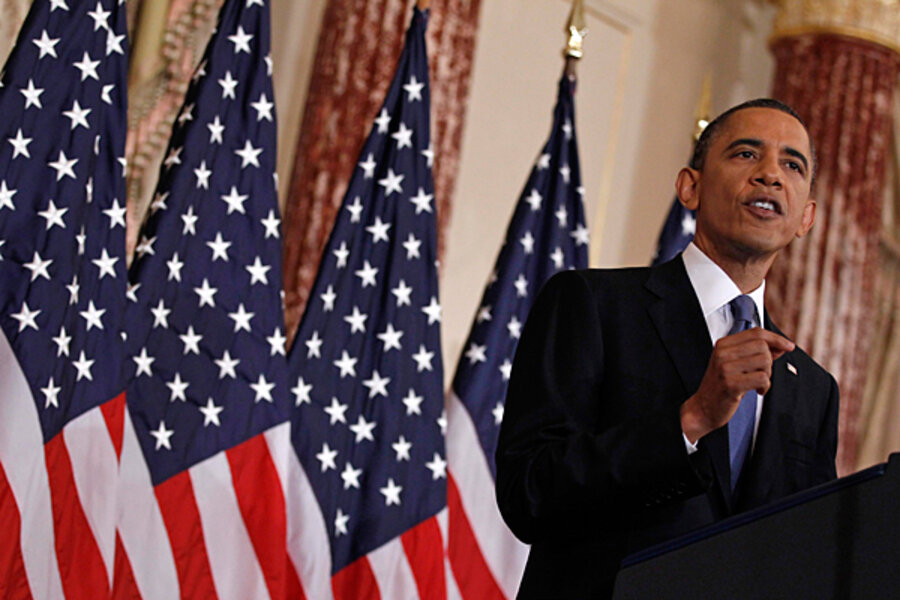Obama Middle East Speech: US is with street protesters, not palace dictators
Loading...
| Washington
President Obama’s big Thursday speech on the Middle East aimed to do two difficult things: align the US with the forces of democratic change sweeping the Arab world, and push Israel and the Palestinians toward real progress on a peace pact.
Both tasks are so big they can’t be accomplished by 45 minutes of presidential rhetoric alone. But one leading US expert judges that Mr. Obama at least outlined a promising way forward for US diplomacy in the region.
“It was a very important description of the balance US policy has to make between values, principles, and security concerns,” says Edward Djerejian, a former assistant secretary of State for Near Eastern affairs.
Not all reactions were so positive. The Israeli government and its closest supporters in the US quickly rejected Obama’s insistence that a Palestinian state should be drawn largely using borders from 1967, prior to the Six-Day War in which Israel captured East Jerusalem, the West Bank, and Gaza.
The 1967 lines are “indefensible,” said Israeli Prime Minister Benjamin Netanyahu following Obama’s address. Mr. Netanyahu is to meet Obama at the White House on Friday in a meeting that now seems sure to be somewhat tense.
Obama’s Thursday address was made necessary by the changes that have swept the Middle East and north Africa during the Arab Spring people's uprisings. The administration's policy has been criticized for an uncertain response to developments that would seem to reflect the US historic insistence on human rights but also threaten the position of regional autocrats who are longtime American allies.
Obama acknowledged that US actions in the Middle East have long been driven by its interests in countering terrorism and nuclear proliferation, securing commerce and regional security, and promoting Israeli security and Israeli-Palestinian peace. (He did not specifically mention the free flow of oil, but that might be inferred from the reference to commerce.)
The US strategy now must broaden beyond the narrow pursuit of these interests, said Obama. It must also take into account the drive for self-determination in Tunisia, Egypt, Libya, Syria, and other Arab world nations.
“After decades of accepting the world as it is in the region, we have a chance to pursue the world as it should be,” said Obama.
Prior to Thursday’s address, a number of experts wondered how tough Obama would be on Syria, where the government has reacted to protesters with a brutal crackdown. Obama stopped short of calling for Bashar al-Assad to step down, but he made it clear that Syria faces further economic sanctions and international isolation if it continues on its current path.
The Syrian people are demanding a transition to democracy, said Obama.
“President Assad ... can lead that transition or get out of the way,” said the US president.
Obama also used blunt language about the behavior of US allies Yemen and Bahrain toward their own protesters. But he did not mention by name another autocratic US ally: Saudi Arabia.
The US chief executive also announced a White House effort to cancel $1 billion in Egyptian debt and guarantee up to $1 billion in new borrowing for Egypt through the US government’s Overseas Private Investment Corp.
“Reinforcing economic growth is an important way of reinforcing a democratic transition,” said a senior administration official who briefed reporters on the initiatives Wednesday.
Both of these big economic moves must be approved by Congress, however – and they face an uncertain future on Capitol Hill.
While most of Obama’s speech focused on reactions to the Arab Spring, a significant portion dwelt on the Israeli-Palestinian peace process, and it is this section that may prove to be the most contentious in days to come.
Obama insisted that a lasting peace must be built on two states, Israel and Palestine, living side by side.
“We believe the borders of Israel and Palestine should be based on the 1967 lines with mutually agreed swaps, so that secure and recognized borders are established for both states,” said Obama.
While this is not a shift in US policy per se, Palestinian leaders have long called for negotiations to begin on this basis. Thus the direct US reference to the ’67 border issue, combined with Obama’s criticism of continued Israeli settlement activity in the occupied territories, appears to be an effort to press Israel to make more concessions to get peace talks rolling.
The border reference is “not new,” says Mr. Djerejian, who also served as a US ambassador to both Israel and Syria and is now director of the James A. Baker III Institute for Public Policy at Rice University in Texas.
What is important, says Djerejian, is that Obama is disagreeing with those who say that given the upheaval in the region it is a bad time to push for Israeli-Palestinian progress.
“To me that is very significant. Delay is not the answer,” says Djerejian.
Some of the Republicans vying to replace Obama in the White House do not see it that way. Ex-Massachusetts Gov. Mitt Romney said after the speech that Obama “threw Israel under the bus” in Thursday’s address.





